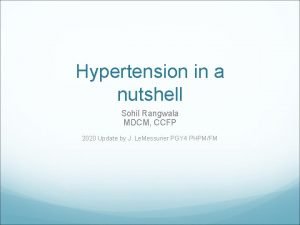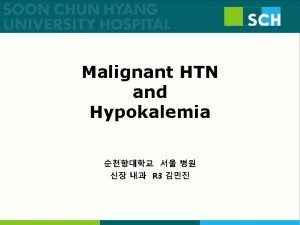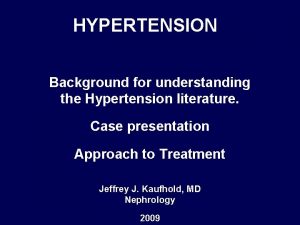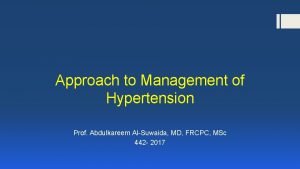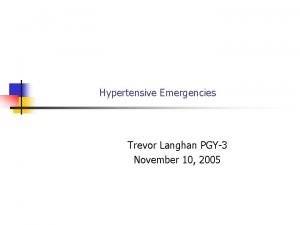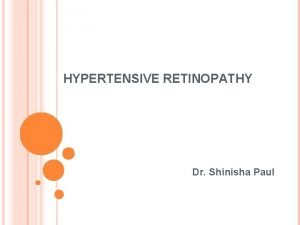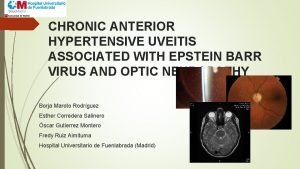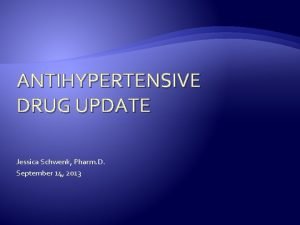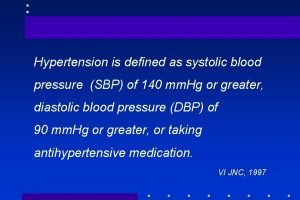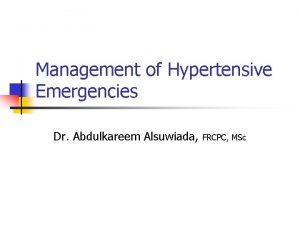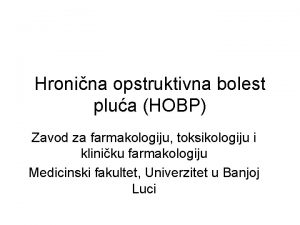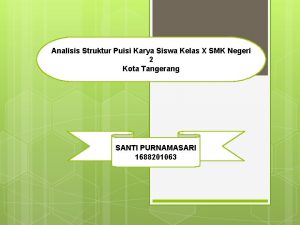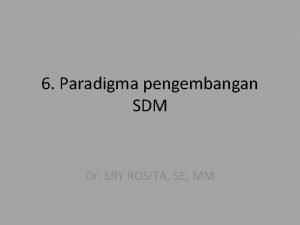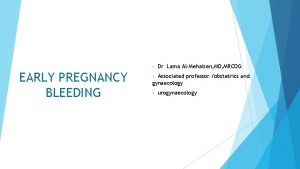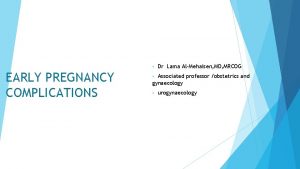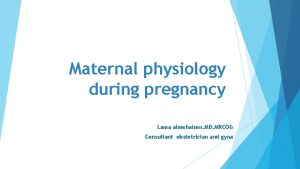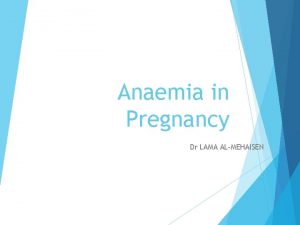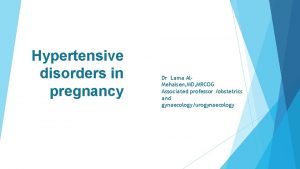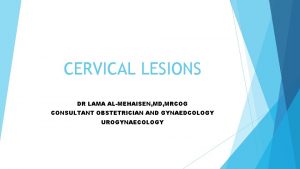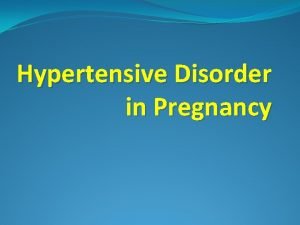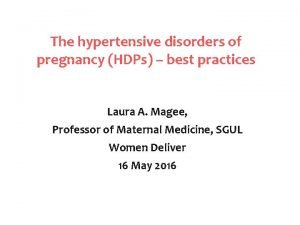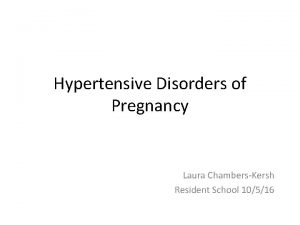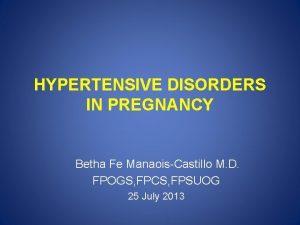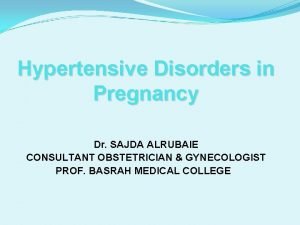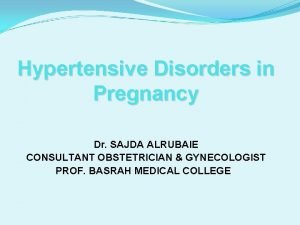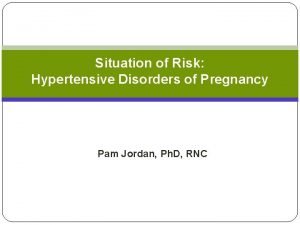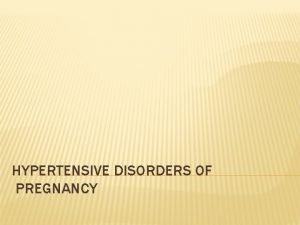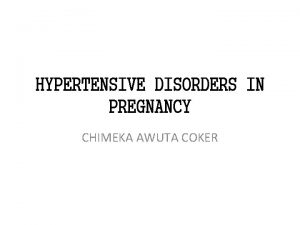Hypertensive disorders in pregnancy Dr Lama AlMehaisen MD






















































- Slides: 54

Hypertensive disorders in pregnancy Dr Lama Al-Mehaisen, MD, MRCOG Associated professor /obstetrics and gynaecology/urogynaecology Dr Lama Al-Mehaisen, MD, MRCOG Associated professor /obstetrics and gynaecology urogynaecology

Classification of hypertension in pregnancy There is now a widely agreed classification system for hypertension in pregnancy. pregnant women who develop or present with hypertension in pregnancy have one of three conditions: Non-proteinuric pregnancy-induced hypertension. Pre-eclampsia. Chronic hypertension.

. Gestational hypertension –Gestational hypertension refers to hypertension (systolic ≥ 140 and <160 mm. Hg, and/or diastolic ≥ 90 and <110 mm. Hg) without proteinuria or other signs/symptoms of preeclampsia-related end-organ dysfunction that develops after 20 weeks of gestation. Development of proteinuria upgrades the diagnosis to preeclampsia. Even without proteinuria, women who develop a systolic blood pressure ≥ 160 mm. Hg and/or diastolic blood pressure ≥ 110 mm. Hg or other features of severe disease are managed with the same approach as women with preeclampsia with severe features.

Chronic/preexisting hypertension – defined as hypertension that antecedes pregnancy or is present on at least two occasions before the 20 th week of gestation or persists longer than 12 weeks postpartum. It can be primary (primary hypertension"essential hypertension") or secondary to a variety of medical disorders Preeclampsia superimposed upon chronic/preexisting hypertension – Superimposed preeclampsia is defined by the new onset of proteinuria, significant end-organ dysfunction, or both after 20 weeks of gestation in a woman with chronic/preexisting hypertension. For women with chronic/preexisting hypertension who have proteinuria prior to or in early pregnancy, superimposed preeclampsia is defined by worsening or resistant hypertension (especially acutely) in the last half of pregnancy or development of signs/symptoms of the severe end of the disease spectrum Eclampsia refers to the development of grand mal seizures in a woman with preeclampsia in the absence of other neurologic conditions that could account for the seizure.

Non-proteinuric pregnancy-induced hypertension (otherwise known as gestational hypertension) is hypertension that arises for the first time in the second half of pregnancy and in the absence of proteinuria. It is not associated with adverse pregnancy outcome and mild and moderate increases in blood pressure in this setting do not require treatment. However, up to one-third of women who present with gestational hypertension will progress to pre-eclampsia.

Chronic hypertension Women who have confirmed hypertension in the first half of pregnancy most likely have chronic hypertension. Chronic hypertension, of whatever type, can predispose to the later development of superimposed pre-eclampsia. Even in the absence of superimposed preeclampsia, chronic hypertension is associated with increased maternal and fetal morbidity and pregnancies complicated by chronic hypertension should therefore be regarded as high risk. The physiological fall in blood pressure that occurs in the first trimester secondary to peripheral vasodilatation can mask chronic hypertension.

egrees of hypertension Mild: diastolic blood pressure 90– 99 mm. Hg, systolic blood pressure 140– 149 mm. Hg. Moderate: diastolic blood pressure 100– 109 mm. Hg, systolic blood pressure 150– 159 mm. Hg. Severe: diastolic blood pressure ≥ 110 mm. Hg, systolic blood pressure ≥ 160 mm. Hg Pre-

PET

Preeclampsia refers to the new onset of hypertension and proteinuria or hypertension and significant end-organ dysfunction with or without proteinuria after 20 weeks of gestation in a previously normotensive woman It may also develop postpartum. Severe hypertension or signs/symptoms of significant end-organ injury represent the severe end of the disease spectrum Oliguria was also removed as a characteristic of severe disease.

PREVALENCE In a systematic review, 4. 6 percent of pregnancies worldwide were complicated by preeclampsia. Variations in prevalence among countries reflect, at least in part, differences in the maternal age distribution and proportion of nulliparous pregnant women in the population Prevalence also varies by gestational age. Preeclampsia is less prevalent before 34 weeks of gestation.

RISK FACTORS 1. Past history of preeclampsia (RR 8) 2. Preexisting medical conditions: 1. Pregestational diabetes This increase has been related to a variety of factors, such as underlying renal or vascular disease, high plasma insulin levels/insulin resistance, and abnormal lipid metabolism 2. Chronic hypertension. fivefold compared with women without this risk factor 3. Systemic lupus erythematosus 4. Antiphospholipid syndrome 3. Prepregnancy body mass index >25 and body mass index (BMI) >30 two- to threefold, 4. Chronic kidney disease (CKD) In some studies, as many as 40 to 60 percent of women were diagnosed with preeclampsia in the latter half of pregnancy 5. Multifetal pregnancy The risk increases with increasing numbers of fetuses

6. First pregnancy (nulliparity) 7. A family history of preeclampsia 8. Prior pregnancy complications associated with placental insufficiency – Fetal growth restriction, abruption, or stillbirth 9. Advanced maternal age (maternal age ≥ 35 , Older women tend to have additional risk factors, such as diabetes mellitus and chronic hypertension, that predispose them to developing preeclampsia. 10. Use of assisted reproductive technology WEAK THEORY

Clinical factors that have been associated with an increased risk of developing preeclampsia Nulliparity Preeclampsia in a previous pregnancy Age >40 years or <18 years Family history of preeclampsia Chronic hypertension Chronic renal disease Autoimmune disease (eg, antiphospholipid syndrome, systemic lupus erythematosus) Vascular disease Diabetes mellitus (pregestational and gestational) Multifetal gestation Obesity Black race Hydrops fetalis Woman herself was small for gestational age Fetal growth restriction, abruptio placentae, or fetal demise in a previous pregnancy Prolonged interpregnancy interval if the previous pregnancy was normotensive; if the previous pregnancy was preeclamptic, a short interpregnancy interval increases the risk of recurrence Partner-related factors (new partner, limited sperm exposure [eg, previous use of barrier contraception]) In vitro fertilization Obstructive sleep apnea Elevated blood lead level Posttraumatic stress disorder

Incidence Pre-eclampsia complicates approximately 2– 3% of pregnancies, but the incidence varies depending on the exact definition used and the population studied. Globally, around 70, 000 women die annually of pre-eclampsia, making it a leading cause of maternal death in low-resource settings. Pre-eclampsia is defined as hypertension of at least 140/90 mm. Hg recorded on at least two separate occasions and at least 4 hours apart and in the presence of at least 300 mg protein in a 24 -hour collection of urine, arising de novo after the 20 th week of pregnancy in a previously normotensive woman and resolving completely by the sixth postpartum week. ( preeclampsia is defined by the new onset of proteinuria, significant endorgan dysfunction,

RISK FACTORS TO DEVELOPING PET Risk factors for pre-eclampsia First pregnancy. Multiparous with a previous history of pre-eclampsia. Pre-eclampsia in any previous pregnancy. 10 years or more since last baby. Age 40 years or more. Body mass index (BMI) of 35 or more. Family history of pre-eclampsia (in mother or sister). Booking diastolic blood pressure of 80 mm. Hg or more. Booking proteinuria ( of ≥ 1+ on more than one occasion or quantified at ≥ 0. 3 g/24 h). Multiple pregnancy. Certain underlying medical conditions: pre-existing hypertension; pre-existing renal disease; pre-existing diabetes; antiphospholipid antibodies.

There is no cure for pre-eclampsia other than to end the pregnancy by delivering the baby (and placenta). This can be a significant problem if pre-eclampsia occurs early in pregnancy, particularly at gestations below 34 weeks. Therefore, management strategies are aimed at minimizing risk to the mother in order to permit continued fetal growth. In severe cases this is often not possible.

The principles of management of pre-eclampsia are Early recognition of the symptomless syndrome. Awareness of the serious nature of the condition in its severest form. Adherence to agreed guidelines for admission to hospital, investigation and the use of antihypertensive and anticonvulsant therapy. Well-timed delivery to pre-empt serious maternal or fetal complications. Postnatal follow-up and counselling for future pregnancies.

Treatment of hypertension The commonest cause of death in women who die of pre-eclampsia in the UK is cerebral bleeding secondary to uncontrolled systolic blood pressure. Therefore, the aim of antihypertensive therapy is to lower the blood pressure and reduce the risk of maternal cerebrovascular accident without reducing uterine blood flow and compromising the fetus. There a variety of antihypertensives used in the management of pre-eclampsia.

Established preventive interventions include low-dose aspirin (typically 75 mg daily), which modestly reduces the risk of pre-eclampsia in high-risk women; calcium supplementation may also reduce risk, but only in women with low dietary intake.

Additional points in management Iatrogenic premature delivery of the fetus is often required in severe preeclampsia. If her condition allows, the mother should be transferred to a center with adequate facilities to care for her baby, and prior to 34 weeks’ gestation steroids should be given intramuscularly to the mother to reduce the chance of neonatal respiratory distress syndrome. In the case of spontaneous or induced labor and if clotting studies are normal, epidural anaesthesia is indicated as it helps control blood pressure. Ergometrine is avoided in the management of the third stage as it can significantly increase blood pressure. Postnatally, blood pressure and proteinuria will resolve. However, in a minority of cases one or both persist beyond 6 weeks and this suggests the presence of underlying chronic hypertension or renal disease. Additionally, a careful search should be made postnatally for underlying medical disorders in women who present with severe pre-eclampsia before 34 weeks’ gestation.


Criteria for the diagnosis of preeclampsia Systolic blood pressure ≥ 140 mm. Hg or diastolic blood pressure ≥ 90 mm. Hg on at least two occasions at least four hours apart after 20 weeks of gestation in a previously normotensive patient AND the new onset of one or more of the following*: • Proteinuria ≥ 0. 3 g in a 24 -hour urine specimen or protein/creatinine ratio ≥ 0. 3 (mg/mg) (30 mg/mmol) in a random urine specimen or dipstick ≥ 2+ if a quantitative measurement is unavailable • Platelet count <100, 000/micro. L • Serum creatinine >1. 1 mg/d. L (97. 2 micromol/L) or doubling of the creatinine concentration in the absence of other renal disease • Liver transaminases at least twice the upper limit of the normal concentrations for the local laboratory • Pulmonary edema • Cerebral or visual symptoms (eg, new-onset and persistent headaches not accounted for by alternative diagnoses and not responding to usual doses of analgesics ¶; blurred vision, flashing lights or sparks, scotomata)

In a patient with preeclampsia, the presence of one or more of the following indicates a diagnosis of "preeclampsia with severe features" Severe blood pressure elevation: Systolic blood pressure ≥ 160 mm. Hg or diastolic blood pressure ≥ 110 mm. Hg on two occasions at least four hours apart while the patient is on bedrest (antihypertensive therapy may be initiated upon confirmation of severe hypertension, in which case criteria for severe blood pressure elevation can be satisfied without waiting until four hours have elapsed) Symptoms of central nervous system dysfunction: • New-onset cerebral or visual disturbance, such as: Photopsia, scotomata, cortical blindness, retinal vasospasm • Severe headache (ie, incapacitating, "the worst headache I've ever had") or headache that persists and progresses despite analgesic therapy and not accounted for by alternative diagnoses Hepatic abnormality: Severe persistent right upper quadrant or epigastric pain unresponsive to medication and not accounted for by an alternative diagnosis or serum transaminase concentration ≥ 2 times the upper limit of the normal range, or both Thrombocytopenia: <100, 000 platelets/micro. L Renal abnormality: Renal insufficiency (serum creatinine >1. 1 mg/d. L [97. 2 micromol/L] or a doubling of the serum creatinine concentration in the absence of other renal disease) Pulmonary edema

DIAGNOSTIC CRITERIA Preeclampsia Professional guidelines generally agree that the diagnosis of preeclampsia should be made in a previously normotensive woman with the new onset of hypertension (systolic blood pressure ≥ 140 mm. Hg or diastolic blood pressure ≥ 90 mm. Hg on at least two occasions at least four hours apart) and proteinuria after 20 weeks of gestation In the absence of proteinuria, the diagnosis can still be made if new-onset hypertension is accompanied by signs or symptoms of significant end-organ dysfunction, as described before.

Preeclampsia with severe features This diagnosis is made after 20 weeks of gestation in previously normotensive women who develop: Systolic blood pressure ≥ 160 mm. Hg or diastolic blood pressure ≥ 110 mm. Hg and proteinuria (with or without signs and symptoms of significant end-organ dysfunction). Systolic blood pressure ≥ 140 mm. Hg or diastolic blood pressure ≥ 90 mm. Hg (with or without proteinuria) and one or more of the following signs and symptoms of significant end-organ dysfunction: New-onset cerebral or visual disturbance, such as: Photopia (flashes of light) and/or scotomata (dark areas or gaps in the visual field). Severe headache (ie, incapacitating, "the worst headache I've ever had") or headache that persists and progresses despite analgesic therapy. Altered mental status. Severe, persistent right upper quadrant or epigastric pain unresponsive to medication and not accounted for by an alternative diagnosis or serum transaminase concentration ≥ 2 times upper limit of normal for a specific laboratory, or both. <100, 000 platelets/micro. L. Progressive renal insufficiency (serum creatinine >1. 1 mg/d. L [97. 3 micromol/L]; some guidelines also include doubling of serum creatinine concentration in the absence of other renal disease). Pulmonary edema.

OVERVIEW OF PATHOPHYSIOLOGY It involves both maternal and fetal/placental factors. Shallow placentation and failure to remodel the spiral arteries of the decidua and myometrium early in pregnancy, weeks to months before development of clinical manifestations of the disease, have been well documented Failure to establish an adequate uteroplacental blood flow can result in relatively hypoxic trophoblast tissue, which may promote an exaggerated state of oxidative stress in the placenta This appears to alter placental villous angiogenesis, leading to poor development of the fetoplacental vasculature and abnormal vascular reactivity. Placental secretion of antiangiogenic factors (s. Flt-1 and endoglin) that bind vascular endothelial growth factor and placental growth factor in the maternal circulation appears to result in widespread maternal vascular dysfunction, leading to hypertension, proteinuria, and the other clinical manifestations of preeclampsia

CLINICAL PRESENTATION Most affected patients are nulliparous or at high risk for the disease. Most present with new-onset hypertension and proteinuria at ≥ 34 weeks of gestation, sometimes during labor Approximately 10 percent of affected women develop these signs and symptoms at <34 weeks of gestation (ie, early-onset preeclampsia) and rarely as early as 20 to 22 weeks. In approximately 5 percent of preeclampsia cases, the signs and symptoms are first recognized postpartum (ie, postpartum preeclampsia), usually within 48 hours of delivery The degree of maternal hypertension and proteinuria as well as the presence/absence of other clinical manifestations of the disease are highly variable.

Patient evaluation Accurate assessment of blood pressure Routine laboratory evaluation should have a complete blood count, serum creatinine level, liver chemistries (LDH, AST, ALT), and urinary protein determination (protein: creatinine ratio or 24 -hour urine protein). Coagulation studies (prothrombin time, partial thromboplastin time, fibrinogen) are not routinely obtained but are indicated in patients with additional complications, such as abruptio placentae, severe bleeding, or severe liver dysfunction. Assessment of fetal status At a minimum, a nonstress test or biophysical profile is performed. Ultrasound is indicated to evaluate amniotic fluid volume and estimate fetal weight Indications for neurology consultation in women with neurological deficits/ ocular signs and symptoms, or a severe persistent headache that does not respond to a dose of acetaminophen severe headache ("worst headache of my life") is sufficiently characteristic of subarachnoid hemorrhage that this diagnosis should prompt neurology consultation and consideration of imaging

Potential clinical findings Hypertension Epigastric pain Neurologic Headache Visual Generalized hyperreflexia symptoms Seizure Stroke Peripheral Abruptio Oliguria edema Pulmonary edema placentae Transient oliguria (less than 100 m. L over 4 hours) is common in labor or the first 24 hours of the postpartum. Urine output may decrease to <500 m. L/24 hours in women at the severe end of the disease spectrum.

Potential laboratory findings Hemolysis which is a finding in severe disease. Elevation in the serum indirect bilirubin level also suggest hemolysis, whereas elevations in lactate dehydrogenase are usually related to liver dysfunction. Proteinuria – ≥ 0. 3 g protein in a 24 -hour urine specimen. Random urine protein: creatinine ratio ≥ 0. 3 mg protein/mg creatinine (some clinicians opt to confirm presence of ≥ 0. 3 g protein with a 24 -hour collection). Protein ≥ 2+ (30 mg/d. L) Proteinuria generally increases as preeclampsia progresses, but increased urinary protein excretion may be a late finding It usually remains <5 g/day, Elevated creatinine The physiologic increase in glomerular filtration rate (GFR) during a normal pregnancy results in a decrease in serum creatinine concentration, which falls to a range of 0. 4 to 0. 8 mg/d. L. The serum creatinine concentration in women with preeclampsia generally remains in this range or only slightly elevated. A creatinine level >1. 1 mg/d. L indicates the severe end of the disease spectrum.

Decreased platelet count A platelet count less than 150, 000/micro. L occurs in approximately 20 percent of patients with preeclampsia The severe end of the disease spectrum is characterized by a platelet count less than 100, 000/micro. L. Thrombocytopenia is the most common coagulation abnormality in preeclampsia. Hemoconcentration – Hemoconcentration may result from contraction of the intravascular space secondary to vasospasm, as well as capillary leaking. Hematocrit typically increases. Coagulation studies – The prothrombin time, partial thromboplastin time, and fibrinogen concentration are not affected by preeclampsia, unless there additional complications, such as severe thrombocytopenia , abruptio placentae, severe bleeding, or severe liver dysfunction

Liver chemistries Liver function tests are normal, except at the severe end of the disease spectrum Elevation in the serum indirect bilirubin level suggests hemolysis. Abnormalities in liver chemistries are due to reduced hepatic blood flow Hyperuricemia – The association between hyperuricemia and preeclampsia has been known for decades. The cause is most likely related to a reduction in GFR. However, the increase in serum uric acid is often greater than expected for mild reductions in GFR, leading to the hypothesis that decreased tubular secretion or increased reabsorption in the proximal renal tubules

Potential sonographic findings Fetal ultrasound suboptimal fetal growth due to reduced uteroplacental perfusion Fetal growth restriction may be accompanied by oligohydramnios due to redistribution of the fetal circulation away from the kidneys and toward more vital organs, particularly the brain In contrast, preeclampsia that develops clinically at term tends to be associated with fetal growth that is appropriate for gestational age and normal amniotic fluid volume. Fetal anatomy is usually normal. However, three population-based studies have reported a relationship between fetal congenital cardiac defects and maternal preeclampsia, particularly preterm preeclampsia

How to monitor fetal complications in PET Ultrasound fetal assessment of: size; amniotic fluid volume; maternal and fetal Dopplers. Antenatal provides of cardiotocography, used in conjunction with ultrasound surveillance, a useful but by no means infallible indication of fetal wellbeing. A loss baseline variability or decelerations may indicate fetal hypoxia.

Differential diagnoses 1 -Preexisting hypertension versus preeclampsia Hypertension occurring before the 20 th week is usually due to preexisting hypertension rather than to preeclampsia Proteinuria is usually present and increases with time in preeclampsia, occasionally reaching the nephrotic range Preeclampsia is more common in nulliparas than in multiparas. Preeclampsia is more common in older (>40 years) nulliparas 2 -Superimposed preeclampsia Reproductive age women with primary (essential) hypertension typically have no or mild proteinuria, so severe proteinuria suggests development of superimposed preeclampsia. In women with chronic/preexisting hypertension who have proteinuria prior to or in early pregnancy, superimposed preeclampsia is difficult to diagnose definitively, but should be suspected when there is a significant worsening of hypertension (especially acutely) in the last half of pregnancy or development of signs/symptoms associated with the severe end of the disease spectrum. An elevated uric acid level may help to distinguish superimposed preeclampsia from primary hypertension

3 -Exacerbation of preexisting renal disease Significant clues to the diagnosis of preeclampsia with severe features are the presence of systemic manifestations of the disorder, such as thrombocytopenia; increased serum levels of aminotransferases; and visual symptoms Onset of disease in the first half of pregnancy suggests exacerbation of underlying renal disease rather than preeclampsia. Laboratory evidence suggestive of exacerbation of renal disease includes the presence of findings specific for disease activity (eg, low complement levels in a patient with systemic lupus erythematosus, urinalysis consistent with a proliferative glomerular disorder [red and white cells and/or cellular casts]). 4 -Antiphospholipid syndrome Hypertension, proteinuria, thrombocytopenia, and other signs of significant end-organ dysfunction can be seen in antiphospholipid syndrome (APS). The absence of laboratory evidence of antiphospholipid antibodies excludes this diagnosis

5 -Acute fatty liver of pregnancy (AFLP) Anorexia, nausea, and vomiting are common clinical features of AFLP. Low-grade fever can be present in AFLP but does not occur in preeclampsia/HELLP. AFLP is associated with more serious liver dysfunction: hypoglycemia, elevations in serum ammonia, and disseminated intravascular coagulation are common features, while unusual in preeclampsia/HELLP. AFLP is also usually associated with more significant renal dysfunction compared with preeclampsia/HELLP. 6 -Thrombotic thrombocytopenic purpura (TTP) or hemolytic uremic syndrome (HUS) 7 -Exacerbation of systemic lupus erythematosus (SLE) Flares of SLE are likely to be associated with hypocomplementemia and increased titers of anti-DNA antibodies 8 -Pheochromocytoma Symptoms of pheochromocytoma that help to make this distinction include generalized sweating, palpitations, tremor, pallor, dyspnea, generalized weakness, and panic attack-type symptoms.

MANEGMENT AND PROGNOSIS General approach: Delivery — Preeclampsia with features of severe disease is generally regarded as an indication for delivery at ≥ 34+0 weeks of gestation after maternal stabilization or with labor or prelabor rupture of membranes Delivery minimizes the risk of development of serious maternal complications, such as cerebral hemorrhage, hepatic rupture, renal failure, pulmonary edema, seizure, bleeding related to thrombocytopenia, myocardial infarction, stroke, acute respiratory distress syndrome, retinal injury, or abruptio placentae, and fetal complications such as growth restriction and fetal demise With the exception of fetal growth restriction, any of these life-threatening complications can occur suddenly.

PREECLAMPSIA WITH FEATURES OF SEVERE DISEASE Expectant management of selected cases Pregnancies in which the fetus has not attained a viable gestational age, pregnancies ≥ 34 weeks of gestation, and pregnancies in which the maternal and/or fetal condition is unstable are not candidates for expectant management. Attempting to prolong pregnancy in these settings subjects the mother and fetus to significant risks with relatively small potential benefits; therefore, delivery is preferable. Expectant management allows administration of a course of antenatal corticosteroids and may provide time for further fetal growth and maturation. For consideration of this approach, both the mother and fetus should be stable, closely monitored in a hospital with an appropriate level of newborn care, and cared for by, or in consultation with, a maternal-fetal medicine specialist. Limiting expectant management to pregnancies ≥ 24 weeks and <34 weeks of gestation. Selection of appropriate candidates for this approach and management of these pregnancies are discussed separately.

PREECLAMPSIA WITHOUT FEATURES OF SEVERE DISEASE General approach Term pregnancies: Delivery — at ≥ 37 weeks of gestation (HYPITAT trial ) Women with preeclampsia benefited from early intervention, without incurring an increased risk of operative delivery or neonatal morbidity: Routine induction was associated with a 30 % reduction in the composite maternal outcome The induced group had a significantly lower rate of cesarean delivery Preterm pregnancies: Expectant management At preterm gestational ages, the risks of serious sequelae from disease progression need to be balanced with the newborn risks from preterm birth. When mother and fetus are stable However, at any gestational age, evidence of severe hypertension, or nonreassuring tests of fetal well-being are generally an indication for prompt delivery. Prior to 34+0 weeks, guidelines from major medical organizations generally recommend expectant management of preeclampsia without features of severe disease,

Components of expectant management Inpatient versus outpatient care Patient education Activity Laboratory follow-up Monitoring blood pressure and treatment of hypertension. Assessment of fetal growth Assessment of fetal well-being Antenatal corticosteroids Timing of delivery

INTRAPARTUM MANAGEMENT Route of delivery The route of delivery is based on standard obstetrical indications. Intrapartum monitoring Continuous maternal-fetal monitoring is indicated intrapartum Fluids Fluid balance should be monitored closely to avoid excessive administration, since women with preeclampsia are at risk of pulmonary edema and significant third-spacing, especially at the severe end of the disease spectrum. A maintenance infusion of a balanced salt or isotonic saline solution at approximately 80 m. L/hour is often adequate for a patient who is nil by mouth and has no ongoing abnormal fluid losses, such as bleeding Oliguria that does not respond to a modest fluid bolus (eg, a 300 m. L fluid challenge) suggests renal insufficiency and should be tolerated to reduce the potential for iatrogenic pulmonary edema In patients with renal insufficiency, it is important to revise the maintenance infusion rate to account for the volume of fluid used to infuse intravenous medications. Management of hypertension Severe hypertension in labor should be treated promptly with intravenous labetalol (avoid in patients with asthma) or hydralazine or oral nifedipine to prevent stroke Antihypertensive medications do not prevent eclampsia.

ANTIHYPERTENSIVE MEDICATION Methyldopa is a centrally acting antihypertensive agent It has a long-established safety record in pregnancy. However, it can only be given orally, it takes upwards of 24 hours to take effect and has a range of unpleasant side-effects include ng sedation and depression. These properties limit its usefulness. Labetalol is an alpha-blocking and beta-blocking agent. It has a good safety record in pregnancy and can be given orally and intravenously. It is the first drug of choice in most national guidelines including the current National Institute for Health and Care Excellence (NICE) guideline, Hypertension in Pregnancy. Nifedipine is a calcium-channel blocker with a rapid onset of action. It can, however, cause severe headache that may mimic worsening disease. In severe cases of fulminating disease, an intravenous infusion of hydralazine or labetalol can be titrated rapidly against changes in the blood pressure.

Drug Initial dose Follow-up • Repeat BP measurement at 10 -minute intervals: If BP remains above 20 mg IV gradually over 2 minutes. Labetalol A continuous IV infusion of 1 to 2 mg/minute can be used instead of intermittent therapy or started after 20 mg IV dose. Requires use of programmable infusion pump and continuous noninvasive monitoring of blood pressure and heart rate. target level at 10 minutes, give 40 mg IV over 2 minutes. • If BP remains above target level at 20 minutes, give 80 mg IV over 2 minutes. • If BP remains above target level at 30 minutes, give 80 mg IV over 2 minutes. • If BP remains above target level at 40 minutes, give 80 mg IV over 2 minutes. Cumulative maximum dose is 300 mg. If target BP is not achieved, switch to another class of agent. Adjust dose within this range to achieve target blood pressure. Cumulative maximum dose is 300 mg. If target BP is not achieved, switch to another class of agent. • Repeat BP measurement at 20 -minute intervals: If BP remains above target level at 20 minutes, give 5 or 10 mg IV over 2 minutes, depending on the initial response. • If BP remains above target level at 40 minutes, give 10 mg IV over 2 minutes, depending on the previous response. Cumulative maximum dose is 30 mg. If target BP is not achieved, switch to another class of agent. Hydralazine 5 mg IV gradually over 1 to 2 minutes. * Adequate reduction of blood pressure is less predictable than with IV labetalol. Nifedipine immediate release 10 mg orally. May be associated with precipitous drops in BP in some women, with associated FHR decelerations for which emergency cesarean delivery may be indicated. As such, this regimen is not typically used as a first-line option and is usually reserved only for women without IV access. If used, FHR should be monitored while administering short-acting nifedipine. Nifedipine extended release 30 mg orally. Nicardipine (parenteral) The initial dose is 5 mg/hour intravenously by infusion pump and can be increased to a maximum of 15 mg/hour. Onset of action is delayed by 5 to 15 minutes; in general, rapid titration is avoided to minimize risk of overshooting Adjust dose within this range to achieve target BP. dose. Requires use of a programmable infusion pump and continuous noninvasive monitoring of blood pressure and heart rate. • Repeat BP measurement at 20 -minute intervals: If BP remains above target at 20 minutes, give 10 or 20 mg orally, depending on the initial response. • If BP remains above target at 40 minutes, give 10 or 20 mg orally, depending on the previous response. If target BP is not achieved, switch to another class of agent. If target BP is not achieved in 1 to 2 hours, another dose can be administered. If target BP is not achieved, switch to another class of agent.

Seizure prophylaxis Candidates for seizure prophylaxis We administer intrapartum and postpartum seizure prophylaxis to all women with preeclampsia, based on data from randomized trials that demonstrated that magnesium sulfate treatment reduced the risk of eclampsia as seen In the MAGPIE trial (magnesium sulfate for prevention of eclampsia trial) It is important to emphasize that seizure prophylaxis does not prevent progression of disease unrelated to convulsions. Approximately 10 to 15 percent of women in labor with preeclampsia without severe features will develop signs/symptoms of preeclampsia with severe features (eg, severe hypertension, severe headache, visual disturbance, epigastric pain, laboratory abnormalities) or abruptio placentae, whether or not they receive magnesium therapy We do not administer seizure prophylaxis to women with only gestational hypertension pregnancyrelated hypertension it is recommended that magnesium sulfate should be used for the prevention and treatment of seizures in women with preeclampsia with severe features.

Seizure prophylaxis Magnesium sulfate magnesium sulfate was safer and more effective for prevention of recurrent seizures than phenytoin, diazepam, and pethidine). The primary effect is thought to be central. Hypotheses states its function as membrane stabilization in the central nervous system secondary to its actions as a nonspecific calcium channel blocker Another theory is that it promotes vasodilatation of constricted cerebral vessels by opposing calcium-dependent arterial vasospasm, thereby reducing cerebral barotrauma Contraindications myasthenia gravis pulmonary edema

Timing Magnesium sulfate for seizure prophylaxis is usually initiated at the onset of labor or induction, or prior to and throughout the duration of a cesarean delivery It is usually not administered to stable antepartum patients, but is sometimes given to women with preeclampsia with severe features while they are being considered for expectant management. Prolonged antepartum therapy (more than five to seven days) should be avoided as it has been associated with adverse effects on fetal bones when it was administered for long-term tocolysis

Seizure prophylaxis Rapid infusion of magnesium sulfate causes diaphoresis, flushing, and warmth, probably related to peripheral vasodilation and a drop in blood pressure. Nausea, vomiting, headache, muscle weakness, visual disturbances, and palpitations can also occur Dyspnea or chest pain may be symptoms of pulmonary edema, which is a rare side effect. Although magnesium sulfate is a weak tocolytic, labor duration does not appear to be affected by its administration The risk of postpartum hemorrhage, possibly related to uterine atony from magnesium's tocolytic effects, was slightly increased in one trial Rarely, hypocalcemia becomes symptomatic (myoclonus, delirium, electrocardiogram abnormalities). Cessation of magnesium therapy will restore normal serum calcium levels

Toxicity — Magnesium toxicity is uncommon in women with good renal function Toxicity correlates with the serum magnesium concentration: loss of deep tendon reflexes occurs at 3. 5 to 5. 0 mmol/L), respiratory paralysis at 5. 0 to 6. 5 mmol/L), cardiac conduction is altered at >7. 5 mmol/L) cardiac arrest occurs at >12. 5 mmol/L When to check magnesium levels — We obtain serum magnesium levels every six hours as an adjunct to clinical assessment in patients who have: A seizure while receiving magnesium sulfate Clinical signs/symptoms suggestive of magnesium toxicity (eg, absent patellar reflex, respiratory rate ≤ 12 breaths/minute) Renal insufficiency (creatinine >1. 1 mg/d. L [110 micromol/L) Following serum magnesium levels is not required if the woman's clinical status is closely monitored every one to two hours for signs and symptoms of potential magnesium toxicity and no abnormalities are noted.

Antidote Calcium gluconate 15 to 30 m. L of a 10 percent solution (1500 to 3000 mg) intravenously over 2 to 5 minutes is administered to patients in cardiac arrest or with severe cardiac toxicity related to hypermagnesemia Calcium chloride 5 to 10 m. L of a 10 percent solution (500 to 1000 mg) intravenously over two to five minutes is an acceptable alternative but is more irritating and more likely to cause tissue necrosis with extravasation.

POSTPARTUM CARE General postpartum care monitor vital signs every two hours while the patient remains on magnesium sulfate, repeat laboratory tests (eg, platelet count, creatinine, liver function tests) daily until two consecutive sets of data are normal or trending to normal. Postpartum patients receiving both magnesium and opioids are at a higher risk for cardiopulmonary depression. Pain should be controlled with the minimally effective dose of opioid Persistent severe hypertension should be treated; some patients will have to be discharged on antihypertensive medications, which are discontinued when blood pressure returns to normal. Although nonsteroidal anti-inflammatory drugs (NSAIDs) sometimes exacerbate hypertension, NSAIDs should be used preferentially over opioid analgesics [ We suggest frequently monitoring blood pressure in the hospital or at home for the first 72 hours postpartum and if it is in an acceptable range, then blood pressure is measured at a follow-up visit 7 to 10 days postdelivery.

Some patients will require longer monitoring; continued follow-up is needed until all of the signs and symptoms of preeclampsia have resolved. Alternative diagnoses should be sought in those with persistent abnormal findings after three to six months Some women are diagnosed with preeclampsia for the first time after delivery. We suggest administration of magnesium sulfate to those with new-onset hypertension and headache or blurred vision, severe hypertension.

PROGNOSIS Prognostic issues include the risk of recurrent preeclampsia and related complications in subsequent pregnancies and long-term maternal health risks. Recurrence 16 percent developed recurrent preeclampsia and 20 percent developed hypertension alone in a subsequent pregnancy The recurrence risk varies with the severity and time of onset of the initial episode Women with early-onset, severe preeclampsia are at greatest risk of recurrence The risk of preeclampsia in a second pregnancy is much lower (5 to 7 percent) for women who had preeclampsia without severe features in their first pregnancy and less than 1 percent in women who had a normotensive first pregnancy (excluding abortions) Recurrent preeclampsia is more likely following a singleton pregnancy with preeclampsia than a twin pregnancy with preeclampsia

Prevention of recurrence Low-dose aspirin therapy during pregnancy modestly reduces the risk of preeclampsia in women at high risk for developing the disease.
 Spotting in pregnancy
Spotting in pregnancy Hypertensive emergency
Hypertensive emergency Nursing interventions for thyroid storm
Nursing interventions for thyroid storm Hypokalemia
Hypokalemia Hypertensive urgency
Hypertensive urgency Salu bonnet and gunn sign
Salu bonnet and gunn sign Hypertensive urgency
Hypertensive urgency Hypertensive kardiopathie definition
Hypertensive kardiopathie definition Sbp179
Sbp179 Hypertensive encephalopathy
Hypertensive encephalopathy Deflection of veins at av crossing
Deflection of veins at av crossing Hypertensive uveitis
Hypertensive uveitis Htn urgency vs emergency
Htn urgency vs emergency Calcium channel blockers examples
Calcium channel blockers examples Périlimbique
Périlimbique Endorine
Endorine The cardiovascular system chapter 11
The cardiovascular system chapter 11 Case scenario for hypertension
Case scenario for hypertension Teste de personalidade tibetano
Teste de personalidade tibetano Karmina
Karmina Lama/laba/ics
Lama/laba/ics Tibetan personality test pdf
Tibetan personality test pdf Kitab perjanjian lama ditulis dalam bahasa
Kitab perjanjian lama ditulis dalam bahasa Memodenkan ayat
Memodenkan ayat Pengertian demokrasi orde lama
Pengertian demokrasi orde lama Test osobowości wg dalai lamy
Test osobowości wg dalai lamy Cara menangani surat masuk
Cara menangani surat masuk Test dalai lama
Test dalai lama Askes
Askes Lama rotasi bumi
Lama rotasi bumi Wievielter dalai lama
Wievielter dalai lama Eli eli lama azavtani analiza pjesme
Eli eli lama azavtani analiza pjesme Serge lama marie la polonaise
Serge lama marie la polonaise Penyimpangan uud 1945 masa orde lama
Penyimpangan uud 1945 masa orde lama Ics laba
Ics laba Kronologi perjanjian lama
Kronologi perjanjian lama Cardivolol
Cardivolol Levi levi lama sabachthani
Levi levi lama sabachthani Jenis-jenis puisi lama
Jenis-jenis puisi lama Pregnancy childbirth and the puerperium icd-10
Pregnancy childbirth and the puerperium icd-10 Tema-tema teologi perjanjian lama
Tema-tema teologi perjanjian lama Paradigma lama manajemen perkantoran
Paradigma lama manajemen perkantoran Lama cu fete plan paralele probleme rezolvate
Lama cu fete plan paralele probleme rezolvate Logo
Logo Serge lama je voudrais tant que tu sois l
Serge lama je voudrais tant que tu sois l Lama omurga
Lama omurga Lama inhaler
Lama inhaler Tibetan personality test
Tibetan personality test Lama tulku lobsang mantras
Lama tulku lobsang mantras Paradigma pengembangan sdm
Paradigma pengembangan sdm Die made gedicht interpretation
Die made gedicht interpretation Mengapa regionalisasi membutuhkan tahapan yang lama
Mengapa regionalisasi membutuhkan tahapan yang lama Laba, lama
Laba, lama Ejaan lama indonesia
Ejaan lama indonesia Lama permainan sepak bola untuk liga indonesia ialah
Lama permainan sepak bola untuk liga indonesia ialah

